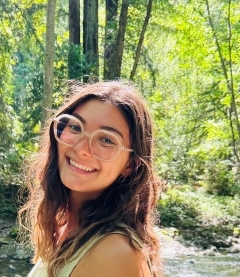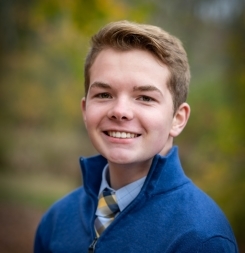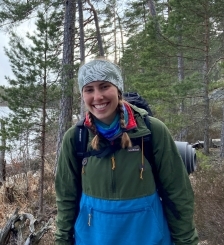Student Profiles
Learn more about the experiences of the alumni of the School of the Environment

Carlyn Rapoport, St. Lawrence University, Environmental Studies
Why did you choose to attend the School of the Environment? I chose to attend the School of the Environment to explore my major, environmental studies, and gain clarity about my future path. I’ve always been uncertain about what specific career I wanted to pursue, something many people my age experience, but SoE has given me genuine insight into what excites me. Through meeting people in and around the Monterey area, I discovered how many different opportunities exist within this field. Choosing to attend the School of the Environment has been one of the best decisions I’ve made, not only for my personal and academic growth, but also for shaping my future aspirations. Along the way, I made meaningful connections and lifelong friends, which made the experience even more impactful. Coming from all different backgrounds, I gained new perspectives from my peers that I never would have gained otherwise.
What was your favorite academic experience? One of my favorite things that we did in Monterey was going snorkeling in a cove near San Carlos Beach. We crawled over thick kelp forests in the freezing water, wearing wet suits to stay warm, while sea otters and seals popped up just a few feet away from us. It was an unforgettable experience and gave everything we’d been talking about in class a deeper meaning, especially our discussions about protecting fragile marine ecosystems.
What is one must see/do/visit thing in Monterey? Spending time along the coastal trail. Conveniently, only a few blocks away from the residence hall, Munras, the scenic coastal trail was my favorite place to walk and run. Stretching 18 miles along the coast, it offers incredible views of the water and an almost guaranteed chance of spotting seals and sea otters any day of the week.
What was your biggest takeaway from SoE? Learning how to “wonder more.” Before my time in Monterey, I was a student in classes that would stay quiet in fear of asking the ‘wrong’ questions. This has caused me to miss out on new knowledge countless times. MSoE has taught me that curiosity fosters learning and allows for change. If our generation wants to create meaningful action, we have to keep asking questions. I’ve learned to stay curious and always wonder more, especially when it comes to environmental leadership.

Nolan Plummer, Middlebury College, Chemistry
Why did you choose to attend the School of the Environment? I chose this program as a way to broaden my experience across different natural science fields. I knew I wanted to follow a STEM-related path going in and was pretty set on Chemistry, but I figured it couldn’t hurt to get some exposure to Environmental Science, and I’m unbelievably glad I did. Beyond the amazing people and experiences, the academics convinced me to follow some passions in the Earth and Climate Sciences world alongside Chemistry.
What was your biggest takeaway? It is important to step outside your comfort zone. I had no prior environmental science experience (or even basic biology, for that matter), but I decided to try SoE anyway. The program is designed to accommodate all levels of knowledge, and so much of the learning is tied directly to the Monterey landscape that you find yourself completely enveloped, no matter your background. Even beyond academics, we found ourselves battling waves in tidepools, kayaking with seals and otters, and traversing unfamiliar terrain with nothing but journals and pencils. The whole program pushed us to try new things, and that experience was absolutely invaluable.
Could you tell us about your favorite class? With my rather devoted passion for the sciences, I was surprised to find that my favorite class ended up being Writing into Wilderness, taught by Allen C. Jones. I went in thinking the class would be more on the “writing poems from a kayak in a lake” sort of vein, but it turned out to be far more intriguing. Allen drew on his experience in writing-based game design, combined with nature-based readings and poems, to teach us about various recombinatory writing systems and how we can utilize divergent thought patterns to their fullest benefit. We really learned how to control our thoughts both inside and outside the proverbial “box,” and honestly, I walked away with a lot of valuable personal lessons.
What surprised you the most about your experience? Obviously, we learned a LOT about how different environmental systems along the central coast function, but I was truly surprised by how much I learned about myself and the friends I made along the way. It is a unique experience to spend six straight weeks in a place none of the twenty-something of us had ever been before, and we really made the best of it with surfing trips, nearly nightly bonfires and ocean cold plunges, and early morning breakfast prep before heading to a tidepool at 6 AM. We also had student-led reflections on Thursday nights with essentially no guidelines, but we all took them as an opportunity to get to know each other better, like writing letters to our future selves or creating a giant string spiderweb by passing a ball of yarn to someone you cared about. Through SoE, we developed not only as academics, but as people, and I think that is what truly matters.
What advice do you have for students considering the program? I understand that being shipped off for six weeks to a town you have never seen before can be scary, but I can promise you it is unbelievably worth it. We all have our fears, for example, I was worried about cooking for myself, but I promise you will find a way to get through them (you’d be surprised how many ways you can make a burrito), and in the process have a genuinely life-changing experience. My advice is simple: go for it. And if you are scared, do it scared. Fear is temporary; memories are forever.

Sophia Hyres, Franklin Pierce University, Environmental Science & Policy
Why did you choose to attend the School of the Environment? The program offered an exciting opportunity to deepen my environmental education and explore subjects not available at my home institution. I was eager for a new experience, one that would push me outside my comfort zone and allow me to engage directly with the material I’d previously only studied in theory. It was also a chance to connect with like-minded individuals who shared my motivations and passion for the environment.
What was your favorite class and why? My favorite class was Wicked Problems taught by Curt Gervich. The curriculum aligned perfectly with my interests in social systems, communication, and problem-solving. The readings were especially insightful, introducing new principles and frameworks for addressing and communicating the climate crisis. Because the course was largely discussion-based, our in-depth conversations helped me understand different perspectives and pushed me to develop and refine my own views. If you have the chance, take this course!
What was the highlight of your time at SoE? While I originally came to the program for the academics and networking opportunities, my favorite memories were made outside the classroom. Whether it was going to the beach before or after class, grabbing smoothies at Perfectly Pressed, or cooking dinner together in the kitchen each night, those everyday moments stood out the most. The people I met through this program truly changed my life, and we’ve stayed close even after it ended. Looking back, the highlight of my time at SoE was the time I spent with the other participants.
One must see/do/visit thing in Monterey is: Try the ice cream at Revival
Do you have any advice for students considering the program? Go into it with an open mind and be ready to step outside your comfort zone. The academic experience is incredibly rewarding, but the connections you make and the opportunities to learn from others are just as impactful. Take advantage of every moment both inside and outside the classroom, and don’t be afraid to engage fully in discussions, activities, and community life. The more you put into the program, the more meaningful and memorable it becomes.

Alexandria Lilly, Virginia Tech, Environmental Science
What was your biggest takeaway? The most profound takeaway this program has shown me is the lasting impact of experiential learning and the connections it fosters with people of all ages, backgrounds, and global locations. Not only did I learn so much through in-class time, but I also learned so much out of class in terms of personal growth and broadening perspectives. The program offered many opportunities to engage with field experts and leaders through thoughtfully arranged excursions. Integrating classroom curriculum with real-world scenarios in important conversations and hands-on experience proved also to be incredibly fulfilling.
What was the best part of being in Monterey this summer? Monterey completely transformed my perspectives on the world, as it revealed to me many new insights, opportunities, and connections I would otherwise not have been exposed to. Monterey is a beautiful place, and it offers so much in terms of biodiversity, natural landscapes, and vibrant community experiences. Additionally, as an epicenter for sustainability and environmental innovation, Monterey also offers valuable lessons in conservation and stewardship of natural resources.
What was your favorite class? Environmental Media Production, taught by Joan Grossman. In this class we were exposed to many different photography and videography production techniques in a very hands-on way. The School of the Environment has many resources, so we were able to practice the techniques learned with high-tech equipment, making our own film projects as well as our own portfolios for photographs. Being able to experience the natural environment of Monterey through a film lens allowed me to express my creativity in so many ways.
What advice would you have for students considering the program? The questions I remember asking myself before applying to the program were: “How will I know this program is right for me?” “Is it worth it?” “What if things go wrong?” Months later, I am here to say taking the leap of faith in applying and then committing to the program was scary, but one-hundred percent worth it. Because everything this program offers is so unique, it is a once-in-a-lifetime experience.
Nicole Craighead, Colorado College, Economics and Mathematics
Why did you choose to do the Middlebury School of the Environment?Going to the School of the Environment, as in taking any summer classes, is inevitably a sacrifice for the employment opportunities you could be pursuing and the money you could be earning during your summer months. But I can’t think of a better use of my time this past summer. The School of the Environment pushes you not just to consider how we can be leaders in the classroom but to go out into communities and meet with policymakers, economists, and farmers to see how you will implement these leadership skills in the years after you graduate.
What was the best part of being in Monterey? Monterey is an exceptional place for any student to spend their summer in. Knowing it to be an affluent region, I was pleasantly surprised to find how grounding a place Monterey was. The community values promoting different cultures, demographics, and even species. Not a day goes by in the summer without a farmers market, and you can’t pass along the Wharf without seeing notices to respect wildlife. Plus, the mild weather was a luxury in a summer of intense heat waves!
What surprised you most about the program? I came into the program knowing that the students and staff would be kind, as it was a Middlebury program. However, my expectations far exceeded my expectations. From the first day, you are well aware that students here are gritty, ambitious, and leaders in all regards, but they also are exceedingly kind and want to learn from one another. The staff are no exception to this: all the teachers I had wanted to work with me to make me excel in the program and beyond my time at SoE; as cliche as it may sound, the teachers genuinely see you as more than a student, and through the many excursions you take with them, the program lends itself to fostering such relationships.
What advice would you give to a future SoE student? Don’t try to do everything. Come into the program ready to work and zone in for the six weeks. Completing three college-credit-bearing courses in six weeks is no easy feat, so be prepared to work. But also don’t forget to explore the environment you are in. After all, the School of the Environment is as much about learning about the environment through classes as it is about learning about it through being outdoors.

Tommy Hillmer, Kenyon College, Environmental Studies
Why did you choose to do the Middlebury School of the Environment? I was unable to go abroad during the academic year and wanted to substitute it with a summer program. An email was sent to the environmental studies majors at my school advertising the School of the Environment, and it seemed like the perfect fit! While it wasn’t “abroad”, I got to experience a new school and new community like I would have in another country.
What was your favorite thing about the program? Definitely the field trips. Our Fridays were reserved for these trips (so no classes!) and we got to kayak with otters in Moss Landing, meet a speechwriter for Cesar Chavez at the United Farm Workers union office in Salinas, go snorkeling in a kelp forest in Monterey Bay, and hiking in Big Sur, just to name a few!
What was your favorite class? Intro to Marine Ecosystems with Professor McKenna. I had never taken a marine biology course before and it made me appreciate just how much the biological diversity that exists in our oceans. We also got to go on several course-specific trips, like to Stanford’s Hopkins Marine Station, the Monterey Bay Aquarium Research Institute, and tidepooling in Garrapata State Park. We got to meet several experts in the field on these trips and it was incredible to see just how much marine biology research was occurring in the Monterey area.

Victoria Alarcon Macias, University of Denver, International Studies
What was your favorite thing about the program? I really enjoyed the connections I made and the life long friendships I gained over the summer. The workshops, guest speakers and the courses where insightful and inspiring. There were so many moments I will never forget.
What surprised you about the program? Monterey! I could have never imagined the beauty of this location. I was in love with Monterey— I enjoyed going on walks, hanging near the beach, and visiting nearby locations in California.
What was your biggest takeaway from the experience? My biggest takeaway was the shared moments with my peers in and out of the classroom. It was fascinating to learn from others about their love for the environment. Our shared love for community and the protection of Mother Earth brought us closer together.

Nicholas Ma, Rice University, Asian Studies and Environmental Studies
Why did you choose to do the Middlebury School of the Environment? I chose to attend the School of the Environment because this is a one-of-its-kind opportunity to get exposed to the multifaceted nature of environmental challenges that we are facing. Specifically, as someone from the Yunnan-Guizhou Plateau in China (the former location of the School of the Environment), I strongly resonated with the curricular approach that incorporates not only the ecological, but also the social, cultural, and policy aspects of issues. I was curious to learn how MSoE applies that framework in a different spatial context in Monterey, California.
What was your favorite thing about the program? My favorite thing was the field trips with experts. Throughout the program, we visited various sites ranging from wastewater treatment plants to farms. I love the experiential learning experience in which we get to learn many hidden aspects of how our environment and society interact with each other in surprising ways.
What surprised you about the program? I was surprised by the community we had in Monterey. Everyone, student, faculty, or staff, were all super friendly and warmhearted individuals who truly care about people and the environment. We had a lot of fun and engaging conversations with each other which shaped me for years to come.
What was the best part of being in Monterey this summer? The best part of Monterey is the scenery. The artist Francis McComas summed it up accurately: “the greatest meeting of land and water in the world.”

Elsa Soderstrom, Middlebury College, Environmental Studies and Geology
Why did you choose to do the Middlebury School of the Environment? The School of the Environment had piqued my interest when I was deciding which college to attend. I loved the idea of an intensive program that brought passionate students together who are dedicated to learning about the environment and the adaptive ways we can combat climate change.
What was your favorite thing about the program? I appreciated the hands-on approach. The School of the Environment places a premium on experiential learning, and I felt like I was able to gain a lot of knowledge while having fun doing so. Classes didn’t feel like a chore, and I was able to explore much of the Monterey region through program excursions.
What was the best part of being in Monterey this summer? Monterey is the ultimate vacation! I had plenty of time to explore the beaches, run the cliff paths, and enjoy the marine wildlife. The weekly farmers markets had the best fresh fruit, and the food overall was delicious. The city is just big enough to have enough to do, but small enough to feel like you really get to know the place.
What surprised you about the program? I came into it not knowing anyone and left with a couple really close friends. It’s amazing how exploring a new place can bring people together so quickly.
What advice would you give to students considering the program? If you have the time and ability to enroll in the program, you won’t regret it. Bring your curiosity and your creativity to be prepared for a nontraditional classroom experience!

Cora Martin, College of William & Mary, Environmental Science & Policy and Latin American Studies
Why did you choose to do the Middlebury School of the Environment? No other program focuses on the type of environmental issues I am interested in: climate change and coastal resilience, international environmental policy, US public service and government work to protect the environment. Middlebury School of the Environment was the only choice!
What was your favorite thing about the program? The best part about being in the program was the people. The professors were brilliant and so kind. I enjoyed every conversation in and out of class with them. The other students in the program were all interested in the same things I am interested in. It was so fun to be around like-minded people learning about really important topics every day together. One girl in the program and I started an environmental podcast after the completion of the program.
I also enjoyed the experiential learning inherent to the program. Every week, we got to meet with amazing US public servants involved with environmental protection in the United States. We explored environmental preserves and conservation sites. It was like getting to go on field trips two to three times a week!
What surprised you about the program? I was surprised by how holistic the program was. You don’t go to Middlebury School of the Environment just to take classes. There are activities, group discussions, games, and movie screenings throughout the six weeks. We were constantly absorbing new information through creative teaching methods.
What advice would you give to students considering the program? Be ready to be busy for six weeks. I made the mistake of taking a remote, asynchronous computer science class during the program, which was almost impossible to manage alongside the School of the Environment. You aren’t going to want to miss out on any experiences or group activities!
